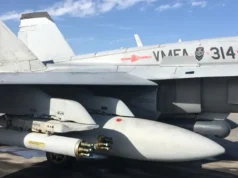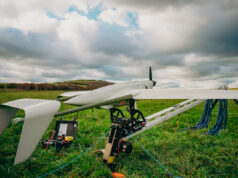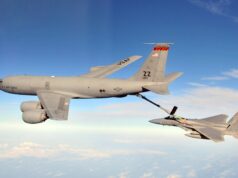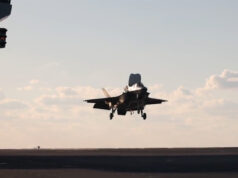Project Brakestop signals the UK’s intent to develop a new long-range strike system cap†able of delivering precision strikes at long range in high-threat environments.
The core objective of Project Brakestop is to deliver a “One-Way Effector (OWE) Heavy”, which can be launched from a mobile platform and strike targets more than 500km away.
The Ministry of Defence has not explicitly defined whether the system required under Project Brakestop will be a missile, drone, or another technology. The notice instead leaves the solution open to interpretation, stating that the One Way Effector (OWE) can be delivered via “any trajectory (ballistic or low level cruise)” and that it should be able to “navigate in a GPS denied environment”.
This ambiguity suggests that the MOD is inviting a wide range of technological proposals, whether that involves a missile, drone, or other forms of strike delivery systems capable of meeting the project’s demanding operational requirements.
According to the Ministry of Defence, the new system must operate in “harsh environments, day and night”, and it should be resilient to “complex electromagnetic environments, including within a GNSS denied & degraded environment.” It must also be resistant to electronic warfare attacks and spoofing, making it highly adaptable to contested, high-risk zones.
Key Specifications for Project Brakestop:
- Range: >500 km
- Payload: 200-300 kg (Mk 82 bomb sized payload)
- Speed: Approximately 600 km/h
- Launch: Ground-launched from a mobile platform
- Cost: Target cost of £400,000 per delivery platform (excluding VAT)
- Guidance: Operable in GPS-denied environments, resistant to EW attacks
- Scalability: Minimum production rate of 20 units per month
The system should be capable of delivering a payload weighing between 200-300 kg, equivalent to the Mk 82 bomb, and maintain a speed of approximately 600 km/h. The project envisions the system being ground-launched from a mobile platform in high-threat environments, ensuring survivability with minimal take-off distance. It should be mobile via a vehicle, either fitted or towed, and should be launched via a ballistic or low-level cruise trajectory, depending on the solution presented.
“It shall be: operable in harsh environments, day and night, of low multispectral signature, resilient in a complex Electromagnetic environment (EME), including within a GNSS denied & degraded environment, and resistant against targeted EW attack and spoofing,” the notice stated.
This indicates a strong emphasis on creating a weapon that can function under a broad range of battlefield conditions, making it difficult for adversaries to detect or disrupt its operations.
The notice outlines several potential solutions, encouraging industry participation, including propulsion systems, airframes, navigation and targeting systems, scalability, and launcher systems.
The MOD has highlighted scalability as a key factor in the project’s development, with the aim of producing a minimum of 20 units per month, with the possibility of increasing production further.
Procurement Process and Timeline
The Ministry of Defence plans to down-select from the proposals submitted and invite a select group of companies to present their solutions face-to-face. The best proposals will receive up to £5 million in funding to rapidly develop and demonstrate their systems.
The project is set to move swiftly, with the first demonstration firing planned for Q2 2025, followed by serial production potentially beginning in Q3 2025. The objective is to deliver this product “at pace”, reflecting the urgency of the requirement and the potential operational role it may play in the near future.
To engage with industry, an industry day is scheduled for October 9, 2024, in London. Companies interested in providing part or all of the solution are encouraged to attend and submit proposals. Due to capacity limits, the event will be restricted to two personnel per company.
Future Capabilities
The project also highlights the government’s long-term goals for defence innovation. The design must allow for “spiral development” to improve performance characteristics over time. The MOD also stated that the design should be free from external government trade and usage restrictions, allowing for greater flexibility in both domestic and international use.
Key government-furnished items (GFX) will be provided as part of the project, including payloads, fuses, testing ranges, and facilities, as well as support from the Manufacturing Technology Centre (MTC) for scaling and advice from the Defence Science and Technology Laboratory (DSTL).
Collaborative Efforts and Ambitious Targets
The MOD has made clear that Project Brakestop prioritises scalability over an “exquisite” solution, ensuring that the system can be produced and fielded rapidly in the numbers required to meet operational needs. In a world of evolving threats, the ability to deploy systems quickly has become a strategic necessity.
“The aim is to deliver this product at pace, which means there is an aggressive timeline of a demonstration firing in Q3 2025 and, subject to contract, potential serial production from Q4 2025,” the notice states. This urgency underscores the MOD’s focus on rapidly developing new capabilities to address emerging threats in contested environments.














500km is not long range.
By what standards? It’s pretty long for a ground-launched system and longer than anything the UK currently has available.
Indeed a pretty good uptick in capability for the army I would say esp in that timeframe. Probably towards the maximum achievable from such a requirement I would have thought though requirements are nebulous enough for flexible interpretation and innovation, but starts to get very sophisticated and expensive I suspect beyond that sort of expectation from a field weapon.
Why? Just buy TLAM.
Attempting to build affordable one way drones for Ukraine.
TLAM is expensive and we probably do t want to pay the listens fees to have a UK line either.
This could also be the home for the quantum laser nav systems that the UK has developed. That could be what unnameable means here?
This is very doable with relatively off the shelf bits TBH. We have the front end. We know the back end systems well.
This is meant to be a much better and very cheap version of Storm Shadow not a Gucci missile.
Yup I think you have sussed out what’s required here. Predominantly. Ukraine requirement but as we see with implications for such weapons foe UK use too.
Relatively capable, relatively cheap, longish range and UK sourced components, or at least free from foreign interference wherever possible, hopefully a lesson we have learned from Ukraine where even Switzerland can dictate whether we can sell uk produced weaponry. The time scale will mean nearly all of it will have to be off the shelf or modified content, though the proposed Mako missile shows how new production techniques can simplify, speed up and reduce costs of new structural and component elements for both quick prototyping and thereafter production.
Will be interesting to see what comes out of this, it reminds me of some of the pre war requirements that generated some very different takes on the proposal.
Its over priced 1980’s hardware.
TLAM is still probably the cheapest long range land attack missile there is. It has a range close to 2000km
Not for long though, lots of cheap new weapons like this one on the horizon.
Why buy someone else’s tech, When you can be the one selling your own?
Is this as well as FC/ASW?
Yes, it’s ground launched instead of air/ship launched.
Thought so. This seems like a luxury not a necessity like FC/ASW is. Unless we are going to war with France or Ireland I’m not sure I see the point at this moment in time. Maybe we are acquiring a new base in Mongolia. We could target Russia and China then 😃
We do have troops in Estonia as part of NATO deterrence, and if the launchers were placed there we would have range over quite a lot of Russia.
These would then play merry havoc with any bridges, motorways, train lines and logistics depots in Russia that are needed to move and maintain the large formations their army rely on.
Yep I appreciate that. Estonia right next to where our astutes and typhoons would be patrolling. Don’t get me wrong it’s a nice asset to have if everything else was up to scratch. Personally I think the time, resources and money would be better spent elsewhere e.g another 1000 sea/air launched missiles or if it’s funds for the army another sky sabre or 2. Enjoy your day ✌️
If things kick off in the Baltics we will need every weapon we can get out hands on in Russias back yard to resist the initial push. There is no guarantee in those early days Typhoons or even naval units will find it easy operating there esp in Estonia. Land launched missiles in large numbers will be required and we have nothing presently to fulfil that brief and remain survivable. The brief sounds superficially quite sophisticated but in reality this is mainly in reference to resisting jamming and spoofing which Ukraine is showing is becoming a vital ingredient to any guided munition so I believe this is a call to arms for innovative techniques that will in themselves be vital to nearly all other new and upgraded systems. And it is not inevitable that those innovations need to be especially ultra costly especially if it reduces the number of missiles used and the efforts required to prepare and make for example Stormshadow strikes effective.
Sense be spoken here methinks 👍 We spend so much time discussing Ukraine ( quiet rightly ) and lessons learned but then do nothing. October 09 2024 is a year gone by, did anything come of this, anyone know?
How’s an Astute supposed to get into the Baltic?
That end is shallow and in range of Russian air assets.
Typhoon is going to be tied up doing air defence most likely. Air combat and deep strike isn’t something you can do simultaneously.
If this can be done “cheaply” it will be a very useful addition to deterrence. It is unlikely to become a massive programme and eat money, so I say let it be and see what benefit we can get at the far end.
Deep strike was one of the roles the F35 was bought for, replacing the Tornado GR4. Of course its lifeline now for the Carriers although a very expensive lifeline. Many now relate the F35 to only the Carriers and seemed to forget the RAF use of the ac. But if we stay at only 48 airframes the Carriers will get them because its the only fighter that can operate from them.Typhoon is a very capable aircraft especially in the Air Defence role and in strike ops in uncontested airspace but I would question if it could operate in a European environment in poor weather and contested airspace – that’s when you really need stealth.
Vital in the initial stages of any Russian attack there to hold or slow till reinforcements events can arrive.
Clearly due to timescale it’s a weapon primarily and initially aimed at helping Ukraine, actual range isn’t baked in to the requirement (though a min) just a guide and would be very useful covering Russian occupied parts of Ukraine and useful (to Ukraine) parts of Russia, if that becomes feasible. But a 500 km range to the British Army on the battlefield would be of enormous benefit over relying on more complex and strategic options and adds quick breadth and depth to the precious HIMARS/MLRS systems which is badly needed. After all in any war we will be on the front line especially in the North of Europe supporting NATO members and will need maximum capacity to strike immediately if a Russian attack especially in the Baltic States occurred.
This is likely longer range and cheaper. No fancy seeker etc.
Exactly I think people need to read beneath the headlines here, it’s emphasising survivability in electronic countermeasure environments and this is where the innovation and effort will be focused clearly in an otherwise cheap and mostly current solution or modification most like to reduce cost and time. The current methods in Ukraine seem to be focused on cameras undertaking terminal targeting having used other methods ie gps to get the missile within a given range where the camera can independently take over as that gps et al guidance becomes increasingly inoperative. Like the pre war ‘boffins’, sudden focus can lead to all manner of clever and not necessarily costly developments even if they may only have a limited shelf life.
As an example Ukraine has presently solved the problems of using ‘fire breathing’ drones to help clear trenches, where getting the mixture solution and mechanisms right so as to make them effective was not as simple as a casual viewer might imagine. Even they say the Russians will likely solve the problems within months. In the meantime they are giving a serious advantage and spreading fear on the frontlines.
Or look into the Barracuda-250 Cruise Missile.
Always pleased to hear of new defence projects ,but really think the government should sort out GBAD for our island nation has a priority . 🙄
100%.
France and Italy have both recently purchased more SAMP/T Aster, and some from the later is going to Ukraine. Why isn’t the UK not considering doing the same? Shared inventory pool with T45s Asters.
and complimentary to Sky Sabre. Even the UK’s nuclear deterrent needs protection.
Looks like a 50’s Sci-fi rocket!
cut ‘n paste from the 60s “look n learn” magazine – the trigan empire comic series.😋
I’m sure Dan Dare would approve.
😂
This is the system we were discussing with Germany a couple of months ago, I have been saying we need something like this for some time. Land based is a big mistake because then we need someone near Russia to let us launch from their territory and 500km is way too short.
We need this but it needs 1000km range and it needs to be cargo plane launched
Surely this is just a means of purchasing PrSM through a procurement programme?
The timeframe is unreasonable for a new product and the 500km range is bang on.
The PrSM payload isn’t quite enough, but otherwise the mention of a ballistic trajectory doesn’t make sense.
It does say and very importantly ‘scalable’. Hit something attainable quickly and it can be upgraded, improved and modified thereafter. Too complex and it’s simply obsolete and unattainable before it reaches the start line. This is clearly a request well below the longer term high tech missile options being pursued more strategically, though some of the research may well benefit them as they progress.
Spear 4?
That would be Storm Shadow, the Spear capability programs cover air to ground weapons only:
Spear capability 1 – Paceway IV LGB
Spear capability 2 – Brimstone ATGM
Spear capability 3 – Spear (confusingly has the same name as the capability program) light mid range cruise missiles
Spear capability 4 – Storm Shadow cruise missile
Spear capability 5 – Perseus (I believe it is being called at least) FC/ASW program
As this is for ground launch it would not have a spear classification.
That all looks right, apart from two things:
I think SPEAR 1 and 2 were for upgrades to Paveway and Brimstone, rather than their development. Similarly SPEAR 4 is the Mid-Life Upgrade to SS, rather than the missile itself.
Perseus was just one of the initial concepts for FC/ASW, the dispensing payload one. At the moment it just seems to be called FC/ASW or FOSW.
Thx. So more like son of V1?
The MOD is starting to think about cost effective, quick to produce, significant destruction at long range..ready to test within a year..coffee smelling time. Essential cheap short range ballistic missiles..the MOD is starting to think it’s going to have to exchange and inflict significant pain. Not reading to much into it, but this is prelude to war thinking.
This project is a de facto statement that some w/in the MoD have begun to connect the dots.
Always amazes me despite history, we need a real threat before anyone does, though often very effectively thereafter. Before that point, jobs, influence and pensions for the boys seems to be the overwhelming policy.
Absolutely agree. Hindsight is always 20/20, current vision is sometimes 20/20, foresight is rarely 20/20. Except by denizens of this site. 😉
Agreed, initially I think the Ukraine War ‘thinking’ but yes a realisation that sadly we may be in a wider war thereafter and we need effective relatively cheap but very effective guided munitions and missiles from Day 1. Common sense at last, as presently UK, Germany and France have only enough munitions to last from days to weeks in a real conflict, however much hurt we might inflict during that period.
Oh, good. Another research project for the 22nd century when the other 101 proposals have been discarded.
So why is it requiring test launches within months? Why is it asking for a cost effective and almost immediately usable production solution from the off and deliverable within a year? For once it seems they are getting it right at the initial stages (surely a bonus) so should be congratulated. Yes if it all goes balls it up along the way then that’s the time for criticism. Cynicism now is surely its worst enemy as any decision good or bad will become pointless and the good decision makers frustratingly move elsewhere if that’s the reaction they get from others.
Because I have lost count of the number of projects for drones, missiles, wingman systems and on and on I have seen in the last thirty years. What I haven’t seen is any increases in our services. If you’re right that’s fine. We’ll wait and see.
Finally a brilliant idea from MOD! Low-cost and long-range precision strike is necessary for the army. The US also seeks for this ability from Anduril. It is the key to fight and win a high- intensity warfare.
Another waste of money nonsense.
Too slow and old tech.
Based on what? You don’t even know what the result of the request will be, geez even they don’t. So what is the ‘old’ tech you are referring to, missiles, drones? Just the speed criterion? My first reaction was surprise over speed but reading on I realised this is not a gold plated missile that requirement lies else where it’s for a cheaper, quicker and cheaper option available within a year or so initially but with room to improve. Very effective drones in Ukraine don’t go faster than that, indeed often a lot slower. It’s up to potential suppliers to combine, speed, range within the cost criteria to what they determine is the best solution. Speed, small size and range, certainly unless very complex and costly solutions are applied are not complimentary so for a time effective and budget conscious solution that lends itself to potential mass production and upgradability there needs to be a simpler capability beneath super high tech options. A sort of guided bomb equivalent for land launch. The proposals will hopefully reveal its potential worth but innovative solutions may result especially in the area of resistance to targeting jamming.
The MoD has a long and dismal history of mismanaging defence projects, blowing countless £billions of taxpayers money attempting to procure a British solution to defence needs
DE&S should be restricted to issuing the spec and arranging the testing of prototypes. At all costs they must prevent civil servants nearing retirement from gold-plating the product and interfering in the design.
Prototypes could be tested in a real war-fighting environment with Ukraine assistance, calling the war-criminal Putin’s nuclear bluff and demonstrating British resolve
In this case I would say the ‘British solution’ is specifically due to experience and the Ukraine war where clearly a British controlled solution in this area is seen to be vital to UK interests. That in the short term is so that it can be supplied to Ukraine and whereby its capabilities will be tested where it matters. Note the real core of this request isn’t about a core missile body et al that remains rather nebulous not even defining it as drone or missile essentially. But the emphasis is on the ability for it to resist jamming and spoofing, that’s important.
There has been in peacetime a great reliance on gps as the go to solution. Under perfect conditions this does nearly all you require, it’s ubiquitous, available and very accurate so in peacetime to designers the obvious solution to adopt especially if you think conflicts will be against relatively unsophisticated opponents. The present scenario changes that game reliance on gps increasingly problematic and as we see in Ukraine new or additional options a necessity for longer range munitions and retaining accuracy especially when you are relying on sophistication to match or exceed an enemy’s superior numbers of munitions or personnel. You can’t just replace eps per se and new technology like Starlink presents problems of its own when you have a somewhat madman like Musk deciding who gets access or not, even the US Govt had to threaten him to do the right thing in Ukraine.
So new ideas and concepts are required and required asap and this request seems to be an attempt to generate usable ideas to deal with this problem to add depth and breadth to the available arsenal and concepts that can be utilised wider no doubt. Fact is the peace dividend has clearly made us complacent in such matters and that needs to change and this is a way to achieve at least some measure of it quickly while longer term more complex research takes its usual time consuming road and in an environment that may not be completely indigenous. Layered defence and attack is required.
The GPS signal is generated by satellites in orbit and at ground level, the signal is very weak. This means that its very easy to spoof and/or jam. Evidence from the Ukraine war suggests that the Ukraine has found a way to overcome this and their domestic long range attack drones are extremely accurate.
Musk is a very clever guy, but i’ve seen video of him being interviewed smoking the wacky baccy. It’s prolly best to humour him. The US government ended up paying Ukraine’s Starlink bills
Specifying speed is an error, effectively rules out a ballistic missile system like atacms. Essentially this is a cruise missile system.
At pace = production third quarter of 2025… MOD timescales are amazing… I wonder how much money some consultants will make on talking about this project…
Perhaps it would be quicker and cheaper to talk seriously to Ukraine and get some advice from people who have actual operational experience of operating these types of weapons in a conventional war setting.
Seems likely to be a useful UK sovereign capability (unlike say Tomahawk, or as we have now discovered, Storm Shadow), quickly obtained for essentially petty cash by MOD equipment budget standards. The MOD is probably hoping to operationally test the system in Ukraine well before the end of next year, if the war is still dragging on.